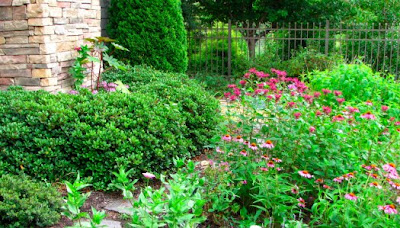For a large, substantial summer annual, the castor bean plant is easy to grow. The big leaves of castor bean (ricinus communis) plant provide an impressive backdrop for bee balm and coneflowers. The dark red stems echo the color of bee balm (monarda) 'Raspberry Wine' and purple coneflowers (echinacea) 'Prairie Splendor'.
When Helen Yoest at Gardening with Confidence™ kindly shared seeds with me when I visited her garden, Helen's Haven, in September 2009, I knew exactly where I wanted to grow the castor bean. I can't be more pleased with the results.
I planted three seeds against our stone chimney, where I wanted an architectural plant to emerge from behind a semi-circle of Indian Hawthorn (rhaphiolepis indica). This planting of shrubs along the cottage garden path prevents both people and pets from getting too close.
TOXIC ALERT! The poisonous castor bean plant is highly toxic and not recommended for those with small children or pets in the garden. Handle seeds with the utmost care.Growing beneath the leaves of the castor bean is a patch of tall garden phlox that was planted in 2006. I wanted a tall plant that could easily be squeezed into the space without disturbing the performance of the purple phlox. Planting seeds was the best solution.
The castor bean will continue to grow taller and taller during the summer and the color scheme will be picked up through the blooms of Benary's Giant wine and lilac zinnias. A few stray zinnias are even growing with the castor bean and phlox!
| Words and photos by Freda Cameron, Defining Your Home, Garden and Travel. |



No comments:
Post a Comment